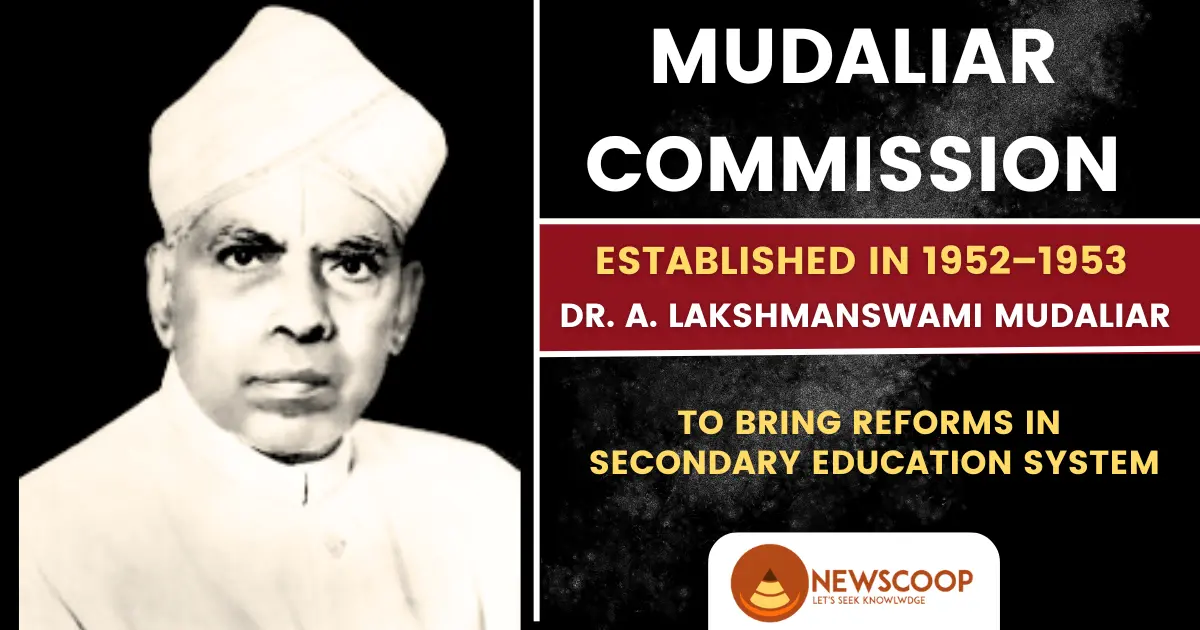Mudaliar Commission (1952-53): Recommendations
Education became a top priority in post-independence India due to the country’s growing population and the need to provide citizens with nation-building skills. This prompted the formation of the Mudaliar Commission, which sought to reform secondary education throughout the country.
Table of Contents
Background and Emergence of Commission
Following India’s independence in 1947, the country faced significant challenges in its educational system. With a growing population and development goals, there was a pressing need to modernize the existing educational system. The schools were few, lacked adequate infrastructure, and frequently used outdated teaching methods. As a result, the educational landscape failed to meet the changing needs of a newly liberated nation.
To address these issues, the government established the Mudaliar Commission in 1952–1953. It was named after Dr. A. Lakshmanswami Mudaliar, the commission’s leader and a prominent educational figure.
The commission was assigned the responsibility of conducting a comprehensive assessment of India’s secondary education system and recommending reforms to ensure its alignment with the country’s development objectives.
Who was Dr. A. Lakshmanswami Mudaliar?
Dr. A. Lakshmanswami Mudaliar was a respected academic who served as the Vice-Chancellor of Madras University. He led the Mudaliar Commission to address issues in secondary education, and his expertise and leadership played a crucial role in the commission’s mission to reform and improve the educational landscape of India.
Objectives
- Investigate secondary education’s challenges.
- Examine the objectives, structure, and content of secondary education.
- Examine how secondary education relates to primary and higher levels.
- Propose effective reforms for secondary education.
- Examine the objectives, curriculum, and teaching standards in various Indian regions.
- Investigate the salaries and working conditions of secondary teachers.
- Assess the facilities and status of secondary schools in each region.
- Examine the exam systems used in secondary education.
Mudaliar Commission Report
The Mudaliar Commission employed two methods to study secondary education across India:
- Questionnaire Method: The Questionnaire Method collects data from a large number of respondents using structured surveys that include standardized questions, allowing for quantitative analysis.
- Interview Method: The Interview Method uses face-to-face discussions to gather qualitative insights, allowing for a more personalized exploration of topics through detailed conversations.
Based on the data collected, the commission compiled a report, submitted to the Government of India on August 29, 1953. This report spans 244 pages, organized into 14 chapters, covering:
- Identification of Shortcomings: Analysis of the deficiencies in the existing secondary education system.
- Proposed Remedies: Detailed recommendations for addressing the identified shortcomings and enhancing secondary education features.
1. Problems in India’s Secondary Education System Before the Mudaliar Commission
Before the Mudaliar Commission, India’s secondary education system had several problems as per the commission’s report:
- Narrow Focus: Secondary education mainly aimed to prepare students for university, neglecting important qualities like teamwork and leadership.
- Irrelevant Curriculum: The things students learned often didn’t seem useful for real life.
- Poor Teaching: Teachers’ methods weren’t engaging or effective, making it hard for students to learn.
- Bad Exams: Exams focused too much on memorizing facts instead of understanding concepts.
- Strict Schedules and Bad Books: Schools had inflexible schedules, and the textbooks weren’t very good.
- Few Activities: There weren’t enough fun or interesting things for students to do outside of class.
- Unclear Teacher Standards: There were no clear rules for who could become a teacher, leading to some unqualified people teaching.
2. Recommendations
1. Organization of Secondary Education:
| Aspect | Details |
|---|---|
| Age Group | 11-17 years |
| Duration | 7 years |
| Division | Junior Secondary (3 years) <br> Higher Secondary (4 years) |
| Elimination of Intermediate | Integrate class 11 into secondary education <br> Integrate class 12 into degrees |
| Multipurpose Schools | Diversified courses at higher secondary level |
| Special Schools | Dedicated facilities for handicapped children |
2. Aims of Secondary Education:
- Democratic Citizenship: Foster the development of democratic values.
- Vocational Skills: Provide practical vocational training.
- Personality Development: Focus on holistic personality growth.
- Leadership Qualities: Cultivate leadership attributes.
3. Curriculum of Secondary Education:
- Real-Life Relevance: Ensure curriculum aligns with practical applications.
- Extensive and Flexible: Offer a broad and adaptable curriculum.
- Interrelated Subjects: Integrate subjects and activities cohesively.
- Leisure Utilization: Enable students to utilize leisure time productively.
4. Educational and Vocational Guidance and Counselling:
- Bureau Establishment: Establish Educational and Vocational Guidance Bureaus in each province.
- School Services: Organize guidance and counselling services within secondary schools, appointing career masters and guidance officers.
- Centralized Training: Provide training for career masters and guidance officers through central government initiatives.
- Individualized Guidance: Tailor guidance based on individual differences, interests, attitudes, aptitudes, and abilities.
5. Curriculum for Junior Secondary Education:
| Subjects | Mother tongue, national language, English, social science, general science, mathematics, arts and music, handicrafts, physical education |
6. Curriculum for Higher Secondary Education:
| Compulsory Subjects | Mother tongue, Hindi or English, social science, mathematics, general science, vocational subject |
| Optional Subjects | Science, Commerce, Humanities, Technical, Agriculture, Fine Arts, Home Science (for girls) |
Also read: Fazal Ali Commission
Shortcomings of the Mudaliar Commission
- Recommendations were made without careful thought.
- Teachers’ financial and social struggles were ignored.
- Not enough focus on educating girls.
- The English language was still given too much importance.
- Vocational training was not fully integrated.
- Exams still need major improvements.
- Recommendations were not put into action well.
- Some areas still have better education than others.
- Not enough support for students with special needs.

